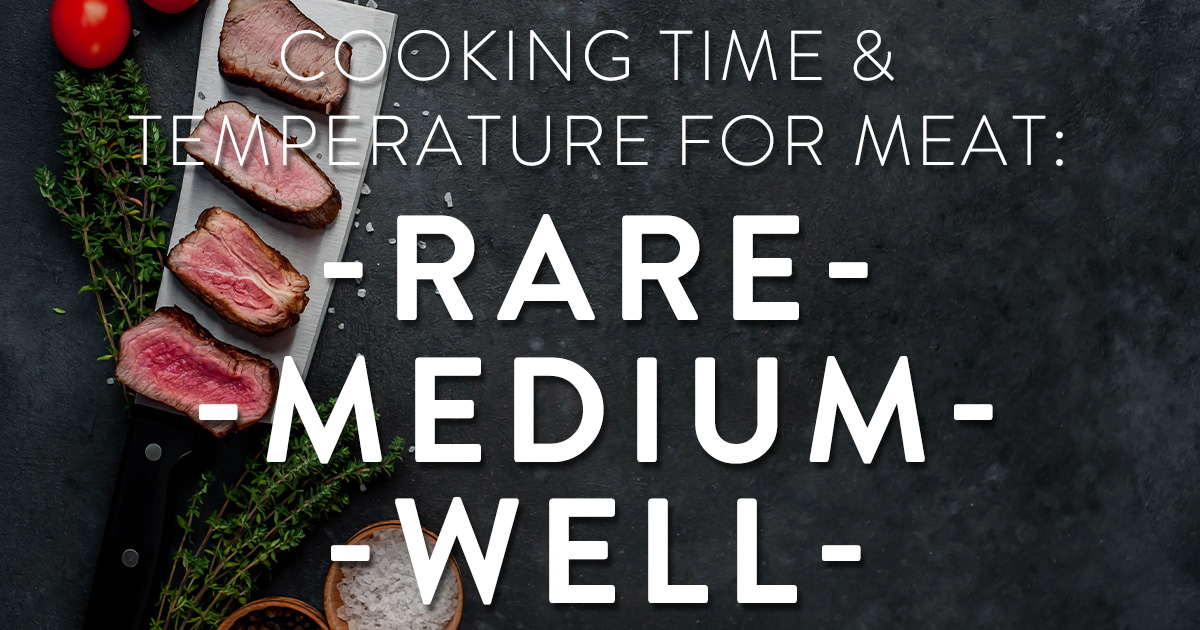
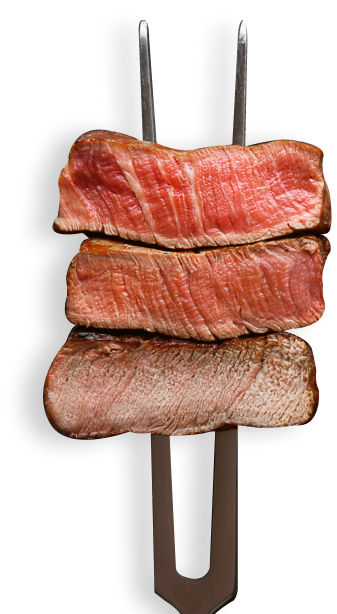
Cooking time and temperature for
Rare
Medium
Well
for each type of meat
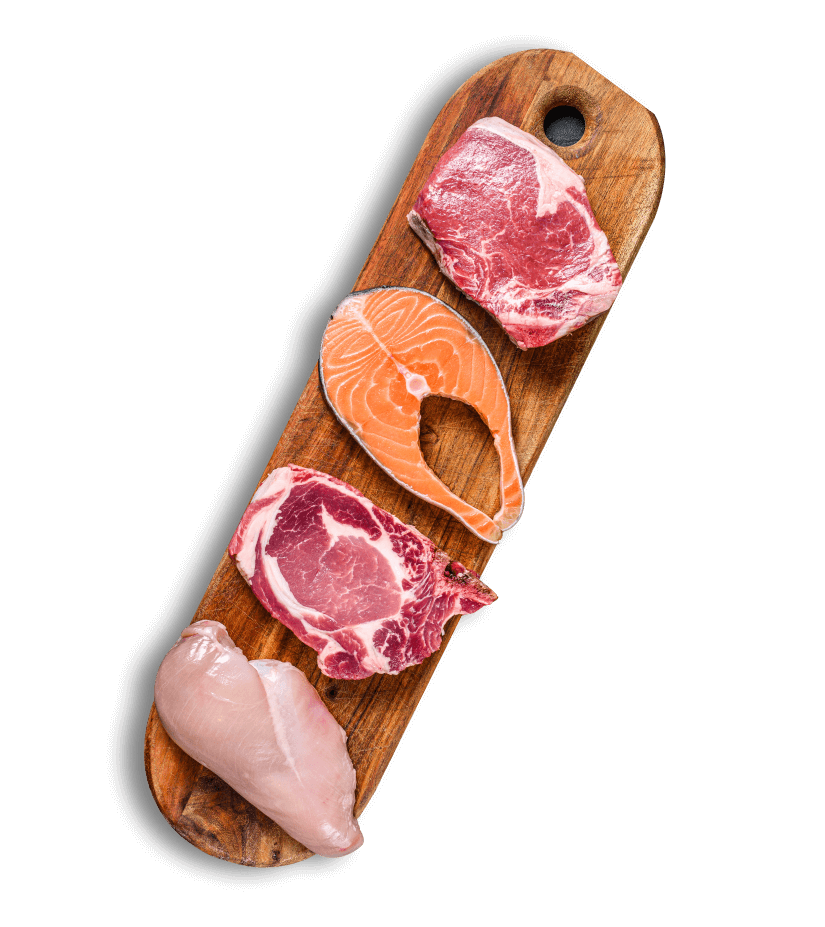
Cooking is undoubtedly a unique kind of science, especially when preparing meat.
While you can improvise many aspects of cooking, meat requires specific cooking times and temperatures to achieve the right finish. More importantly, consuming raw meat can leave you and your guests with a nasty case of food poisoning- something you definitely want to avoid if you don’t want your night to be remembered for all the wrong reasons!
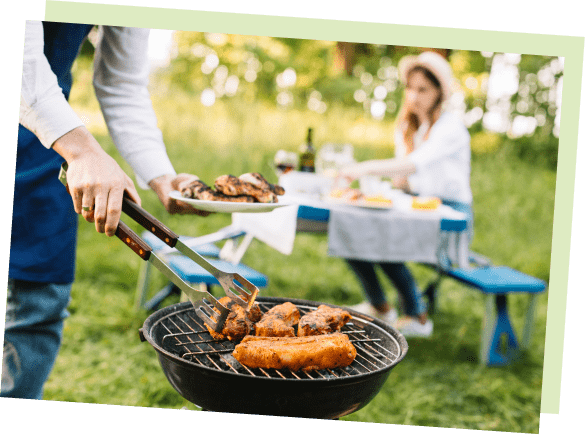
Whether you are cooking for a big party or simply want to spruce up your knowledge, this article is for you!
Continue reading to discover the best cooking time and temperature for each kind of meat, and get ready to show off some mouthwatering skills at your next barbeque.

Levels of
Doneness
Each type of meat requires a different level of meat doneness.
While you can choose the rarity of beef, for example, you must cook chicken thoroughly to prevent illness. At the same time, overcooking your chicken can make it dry and unappetizing. When it comes to cooking meat, time is truly of the essence!
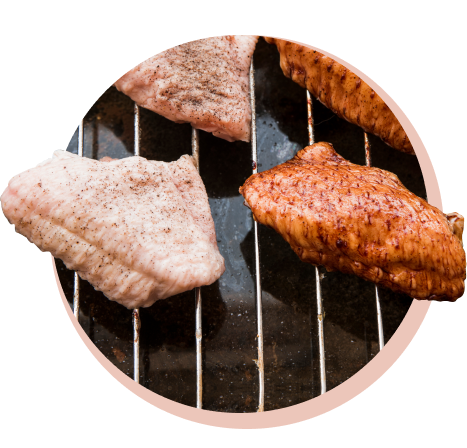
In this section, we will look at the different stages of doneness you can cook your food.
The level at which you cook your meat can change its flavor and texture, affecting the overall experience of your dish. Some recipes may benefit from rare meat, while others need it to be cooked longer. Of course, personal tastes also come into account.
Here is a helpful example of the different levels of doneness you can cook your meat.
Rare
Rare meat is cooked for the least amount of time. It is tender and juicy, which is why it has so much appeal. The blood in the meat brings out a bright red color and bursts of flavor that tantalize the taste buds. While rare meat is a delicacy to many, its appearance can put some people off, while others may not trust that it is safe to eat.

Meat you shouldn’t consume rare
You should undoubtedly cook some meats all the way through and not consume rare. These include poultry such as chicken, turkey, duck, and goose.
Did you Know this about pork?
You should also cook pork well before eating it. This is because bacteria penetrate deep inside these kinds of meat, and the only way to eliminate them is by cooking the meat thoroughly.
Meat safe to eat rare
On the other hand, whole cuts of beef or lamb are safe to eat rare, so long as they are cooked on the outside and warm through the middle. For this section, these will be the meats we refer to when considering levels of doneness.
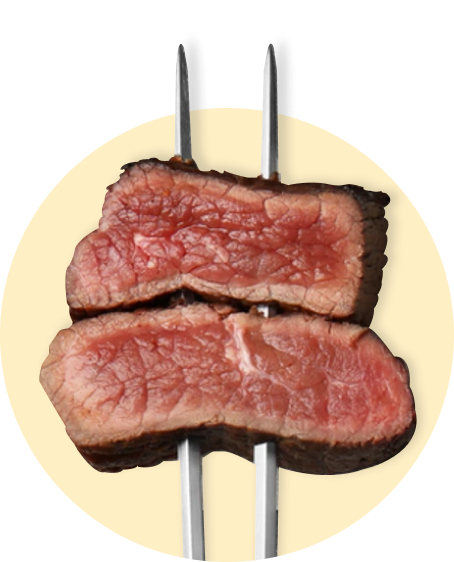
Medium-Rare
Many argue that cooking meat medium rare is the best way to serve it. When cooking a steak medium rare, the meat is pink on the outside and a deeper red in the middle. It is beautifully tender and juicy without appearing raw. Achieving the perfect medium rare finish may seem complicated, but if you cook your meat at the right temperature, you will enjoy the succulence of a juicy meat feast in no time!
Medium
Meat cooked to this level of doneness will have a pronounced pink strip in the middle. It is another favorite amongst meat lovers, tender enough so that the meat isn’t chewy and retains some precious juices. Personal preferences and the cut of your meat are factors in deciding which level of doneness you should cook. Medium is certainly a popular choice amongst many Americans!
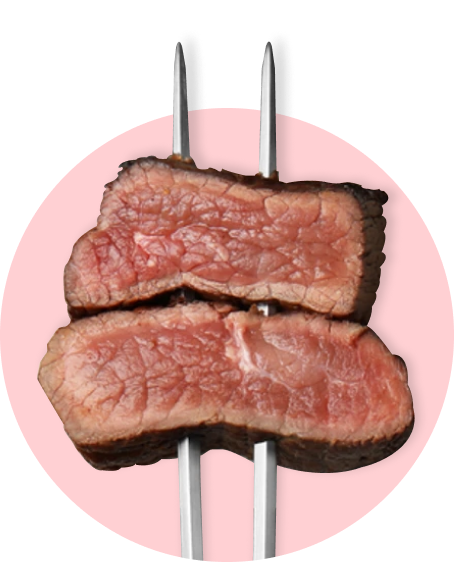

Medium-Well
Perhaps the safe choice for pickier eaters, medium-well meat is browned most of the way through with a slightly pink center and is without red juice after cutting into it. Medium-well meat is less tender than those cooked for less time and is often much drier. Big meat enthusiasts may consider it a crime to cook the steak longer than medium. However, medium-well is still a safe and tasty way to enjoy your meat!
Well Done
Perhaps the safe choice for pickier eaters, medium-well meat is browned most of the way through with a slightly pink center and is without red juice after cutting into it. Medium-well meat is less tender than those cooked for less time and is often much drier. Big meat enthusiasts may consider it a crime to cook the steak longer than medium. However, medium-well is still a safe and tasty way to enjoy your meat!
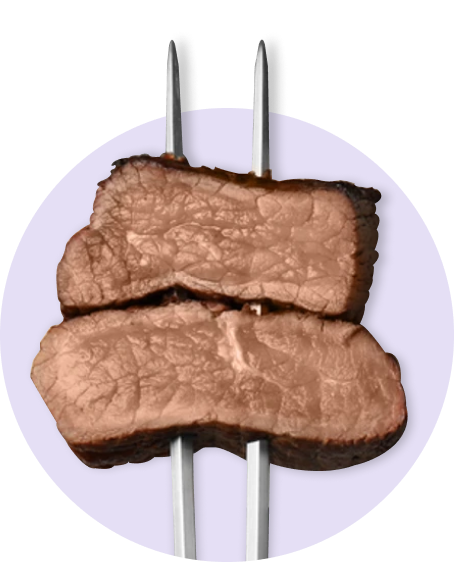
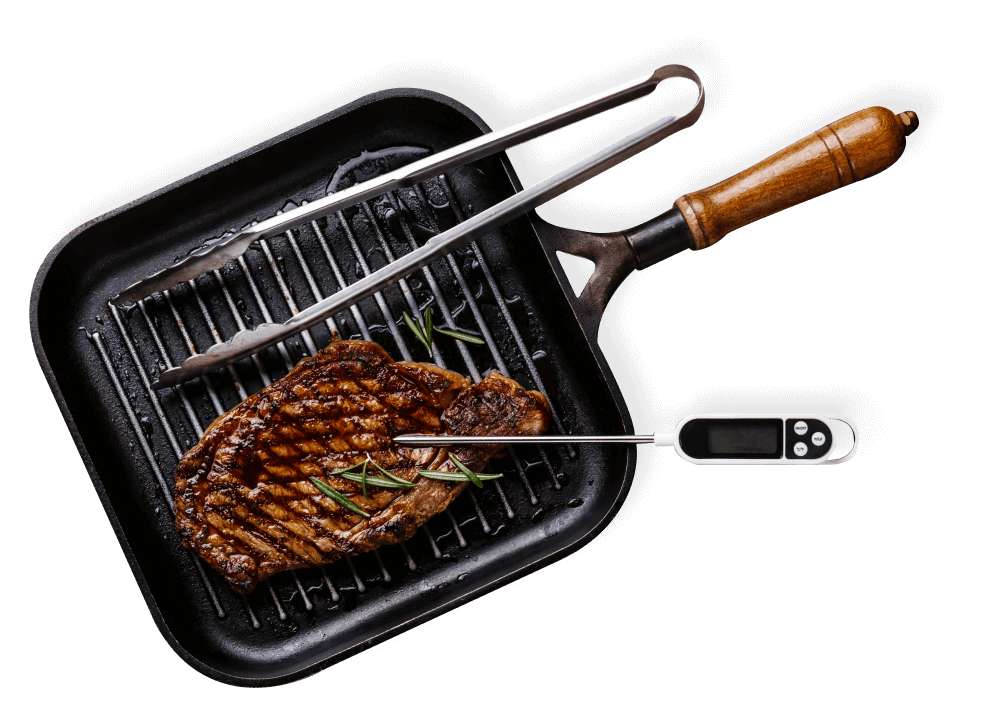
Temperature
You might now be thinking,
How does one achieve a certain degree of doneness on their meat? Since you can’t see what is happening inside the cut of meat, the best way to gauge its doneness is through temperature.
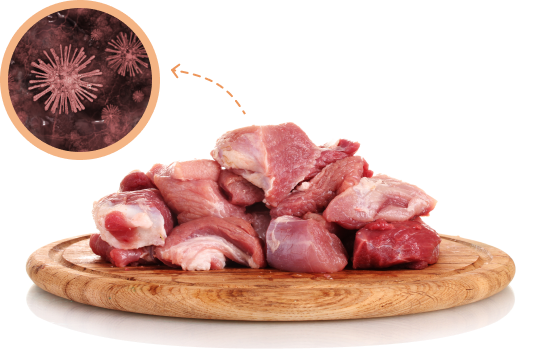
Taking the temperature of your meat is not only the best way to produce the ultimate medium-rare steak but is also best for ensuring the internal temperature of your food is hot enough to dispose of harmful bacteria and prevent foodborne illnesses.
To check the inside meat temperature:
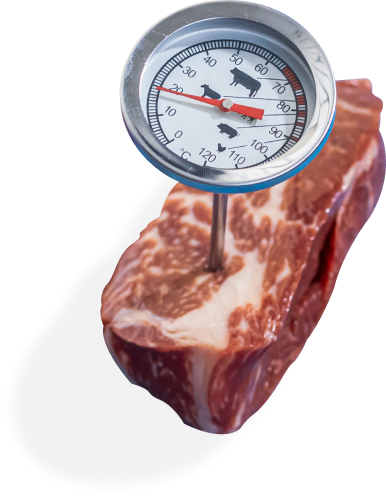
To find the right temperature to cook meat, continue reading our thorough guide, discussing each meat and its ideal internal temperatures.

Check each piece of meat separately and do so when nearing the end of its cooking time. Some meats must rest for at least 3 minutes before carving into them. Rest time allows the temperature inside the cut to rise and kills off remaining bacteria. Resting also prevents the heavenly juices from pouring out your meat as soon as it is cut open, so you get mouthfuls of flavor with every bite!
Beef
Beef is one of the most popular types of meat and allows for experimentation with its doneness.
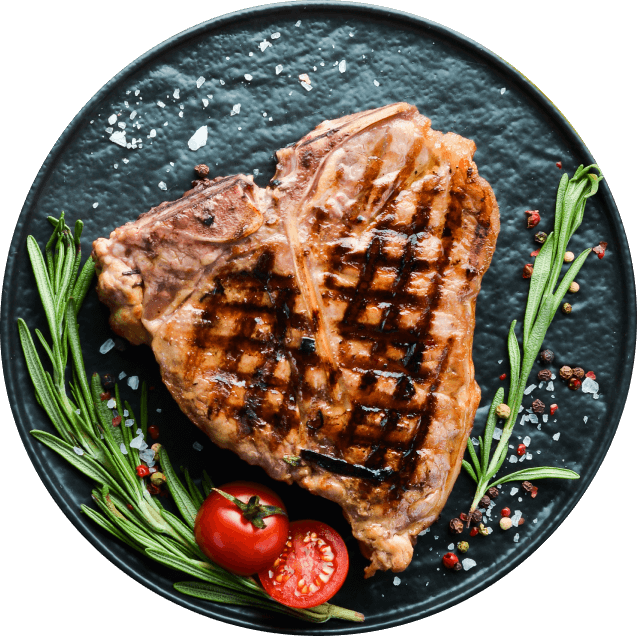
It is rich in protein, vitamins, and minerals, with versatility in how you decide to eat it.
Beef is safer to eat rare than other meats because the bacterial contamination only exists outside the cut (unless it has been cross-contaminated). This means that so long as the outside of your beef steak is cooked and turned brown, it should be safe to eat.
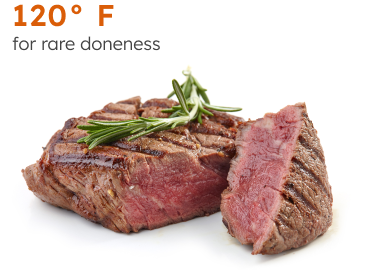
The minimum beef temperature is 120 F for rare doneness, and it shouldn’t be cooked to any less than this. A steak doneness chart is the best way to determine the correct temperature for your desired steak.
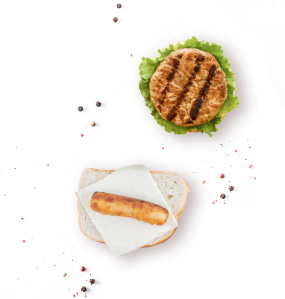
While eating steak at lower temperatures is safe, we recommend that burgers, sausages, kebabs, and rolled joints of meat be cooked well done. With this type of meat, bacteria have a better chance of spreading from the surface to the center.
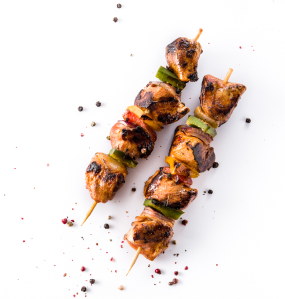
The minimum USDA beef temperature is slightly different. They recommend that the internal temperature for beef steak should be a minimum of 145 F for the safest consumption, with ground beef having an internal temperature of 160 F.

As previously mentioned, beef can be safe to eat at lower temperatures if appropriately handled. However, eating steak at anything lower than medium-well is considered risky by the USDA.
The doneness of your beef depends on the cut and the temperature.
With so many numbers to keep in mind, we have made this handy beef temperature chart showing you the perfect temperatures to cook your beef cut.
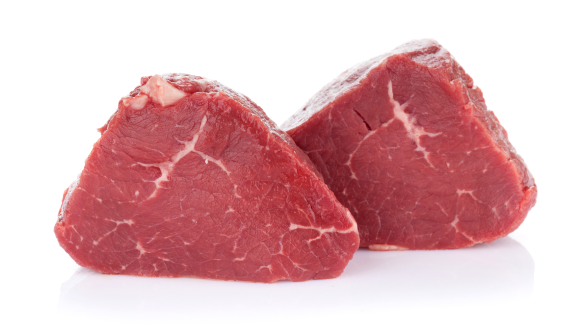
Steak
Steak is a flat beef cut, typically across the grain of the muscle fibers. Steak has different levels of cuts varying in taste, texture, and quality. It is undoubtedly a popular choice in the culinary world and is a luxurious option in many highly-priced restaurants.
Check out our beef doneness temperature chart to easily refine your steak cooking skills
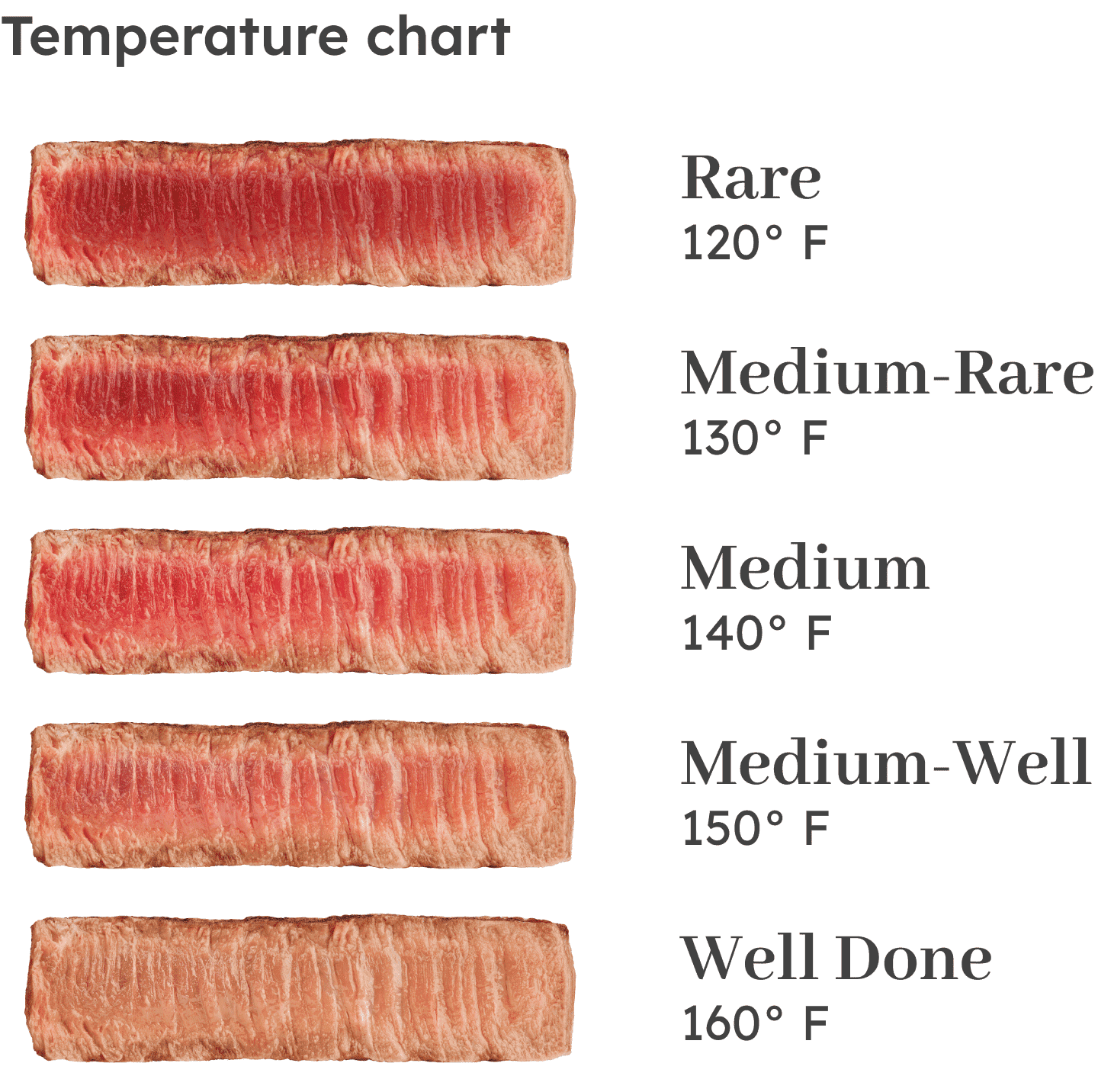

Prime Rib
Prime rib, sometimes known as a standing rib roast, is a classic way to serve beef. These large cuts of beef from the primal rib section are perfect for serving at large holiday dinners. When cooked properly, the meat will fall tenderly off the bone and taste full of flavor. You can find prime rib at most butchers and grocery stores.
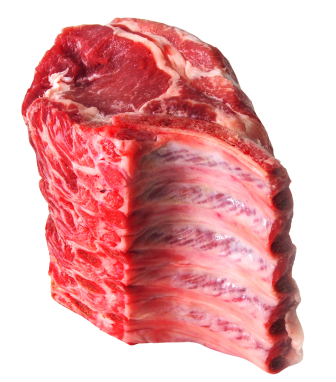
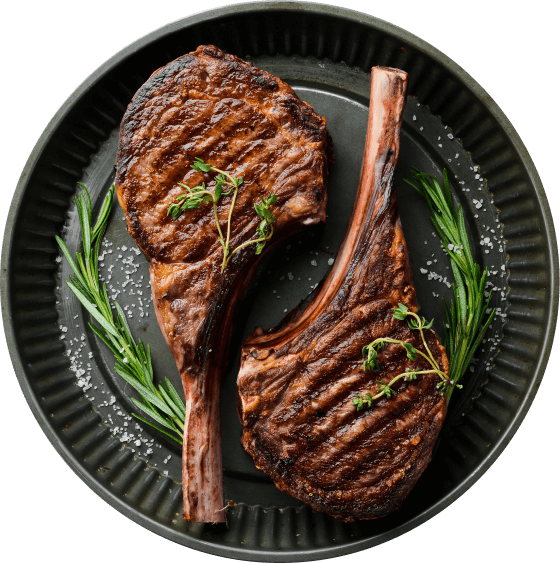
Temperature chart
Rare 115° – 120° F
Medium-Rare 125° -135° F
Medium 135° – 145° F
Medium-Well 150° F
Well Done 160° F
Cooking time on the grill:
Achieving a medium-rare prime rib can be done by cooking the meat for around 2 hours and 45 minutes on the grill. Keep an eye on its internal temperature with a meat thermometer to get it out at the ideal temperature (125- 135 F for medium-rare).
Tri-Tip
A tri-tip is a triangular piece of beef cut from the sirloin subprimal (the bottom of the sirloin). This rich cut is known for being high in flavor and low in fat. Tri-tip has dense marbling for a wonderfully tender texture brought out best when cooked on the grill. Add dry rubs or spice pastes to your tri-tip for that extra kick of flavor.

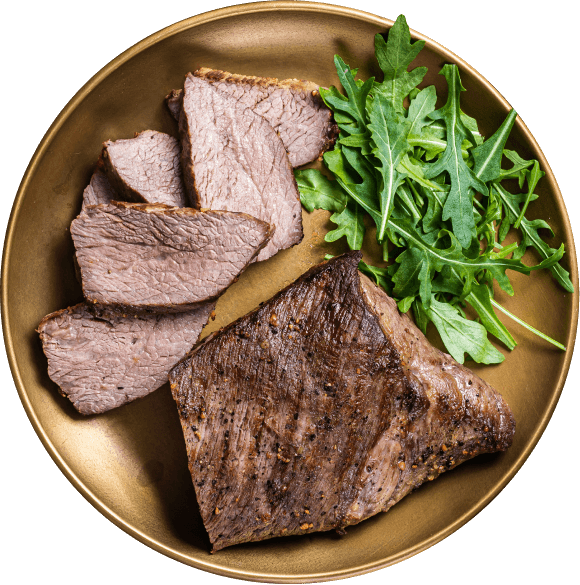
You can cook tri-tips safely to different levels of steak doneness.
Here are the temperatures you will need
Rare 125° F
Medium-Rare 135° F
Medium 135° – 145° F
Medium-Well 150° F
Well Done 160° F
Cooking time on the grill
Rare 15-20 min
Medium-Rare 20-15 min
Medium 25-30 min
Medium-Well 30-35 min
Well Done 40 min
Burger
Typically, you should cook burgers thoroughly before serving them, as harmful bacteria living outside the meat can spread through ground beef more easily. You might see different levels of burger doneness offered at some restaurants. If you need help with how to safely cook your burger, refer to our practical beef temperature guide.
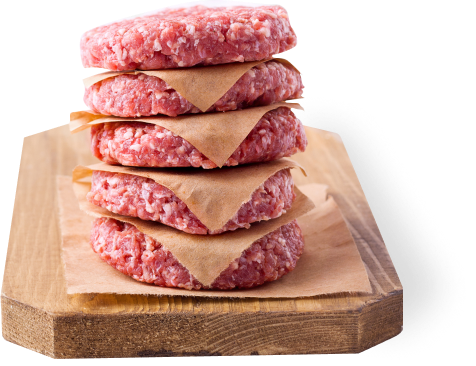
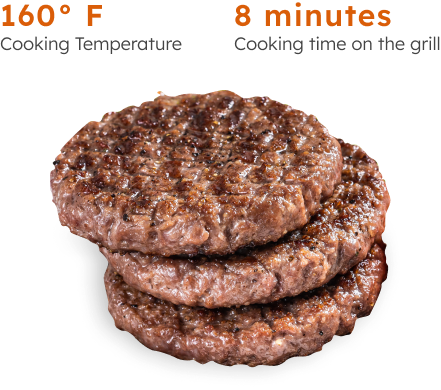
With the proper hygiene, food preparation, and freshness of the beef, you can lower the risk of foodborne illness, but it remains a risk nonetheless. The USDA recommends cooking hamburgers and meatballs to a safe minimum internal temperature of 160 F. Your burger should be brown throughout before serving. This is around 8 minutes on the grill, but keep a check on the beef’s internal temperature to be on the safe side!
Pork
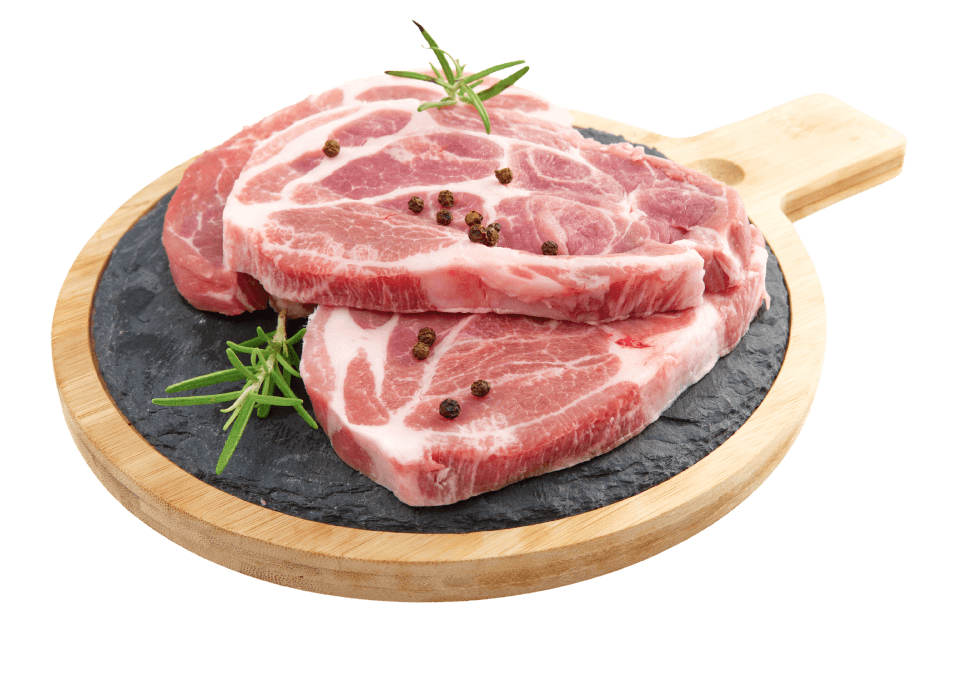
Pork has a lighter flavor than beef, complemented by sweet or tart ingredients.
Pork has a firm texture that chews easily when cooked well. Of course, pork also brings many household favorites. Bacon and sausages are to name a few!
Cooking Pork
Unlike most cuts of beef, you must cook pork fairly well before eating. It is only safe to eat once it reaches an internal temperature of 145 F. We recommend letting your pork rest for 3 minutes after cooking, as the internal temperature continues to rise and kills off any bacteria. Pork does not need to be cooked to the point of looking and tasting tough, however, and can be eaten when it appears a little pinkish. Pork is a very lean meat, so it is important not to overcook it to achieve a tender and tasty pork dish! Fresh-cut pork muscle meats should measure 145 F, but this can change depending on the cut of your meat.
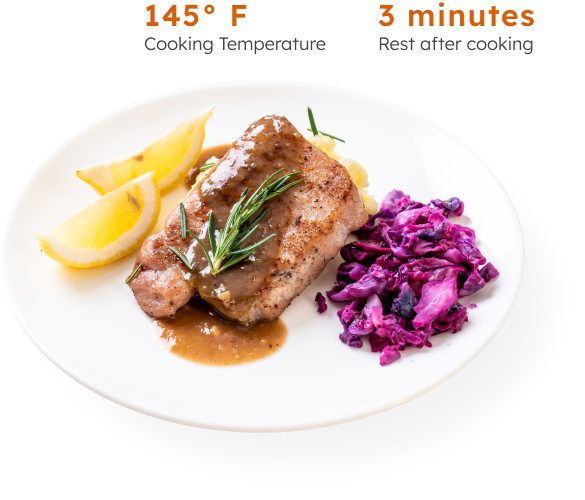
Pork cuts
Like beef, there are varying pork cuts that each offer distinct qualities and flavors. Pork chops are perhaps the most popular cut of pork to cook and eat.

They are cut from the loin and have a tender, lean, and beautifully mild flavor. Pork chops are served on the bone, and you can prepare them in endless ways, from pan-frying to slow-cooking!
Pork tenderloin is another fan favorite among meat fanatics!
The tenderloin is an extended, boneless cut of meat taken from the loin muscle that runs along the back of the pig. It is also called pork steak or the Gentleman’s Cut.
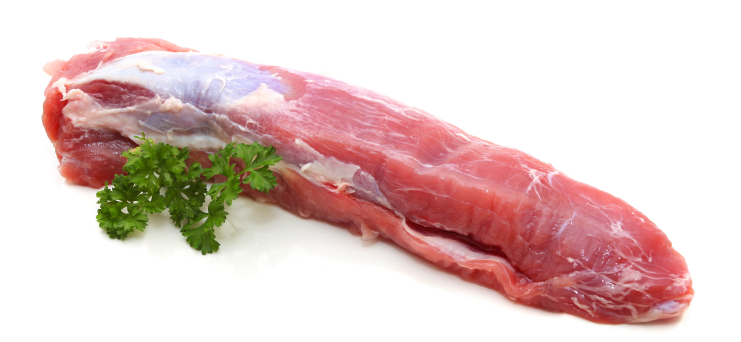
Pork tenderloin
Pork tenderloin is a versatile cut of meat and is great for those days when you need a show-stopping meal done quickly. By itself, pork tenderloin is rather mild-tasting, making it the perfect blank canvas for whatever herbs, sauces, and marinades you throw at it!
Pork tenderloin is not to be confused with its bigger sibling, the pork loin. While they both sound similar, they certainly have differences! The pork loin is wider, flatter, and typically has larger cuts than the tenderloin.
Pork loin is perfect for those on a budget, being the cheaper option out of the two. The loin also has a longer cooking time because of the thickness of the cut, so it’s not a good idea to use them in place of each other in recipes.
Ground pork
When discussing pork temperatures for doneness, this does not apply to ground pork. Much like ground beef, bacteria can spread easily through ground pork. They must be cooked to an internal temperature of 160 F. Sausages should also be cooked to this temperature.
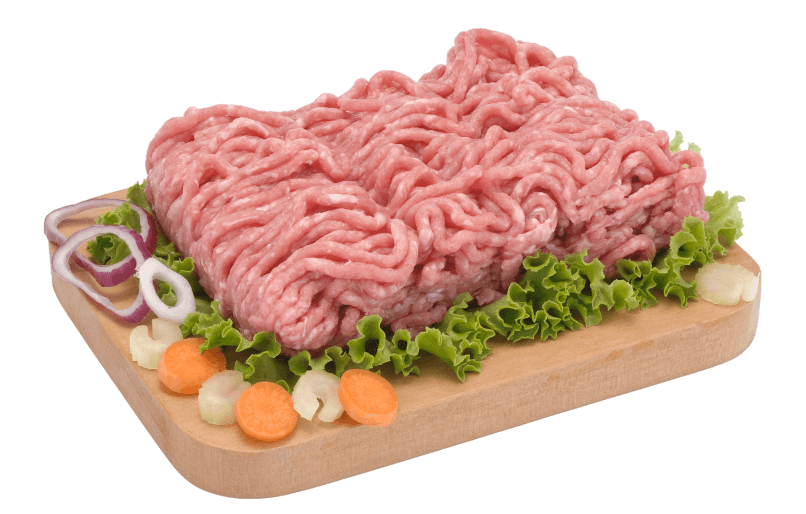
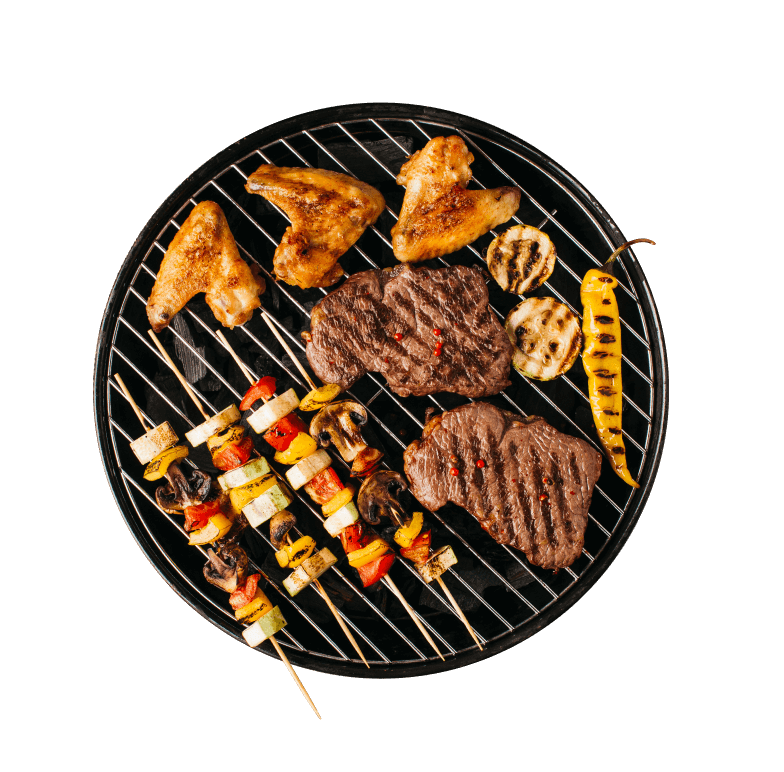
Despite this, there are some varying degrees of pork doneness for most cuts, like the tenderloin, loin and pork chops
Medium-Rare 145° – 150° F
Medium 150° – 155° F
Medium-Well 155° – 160° F
Well Done 160° F
Poultry/ Chicken
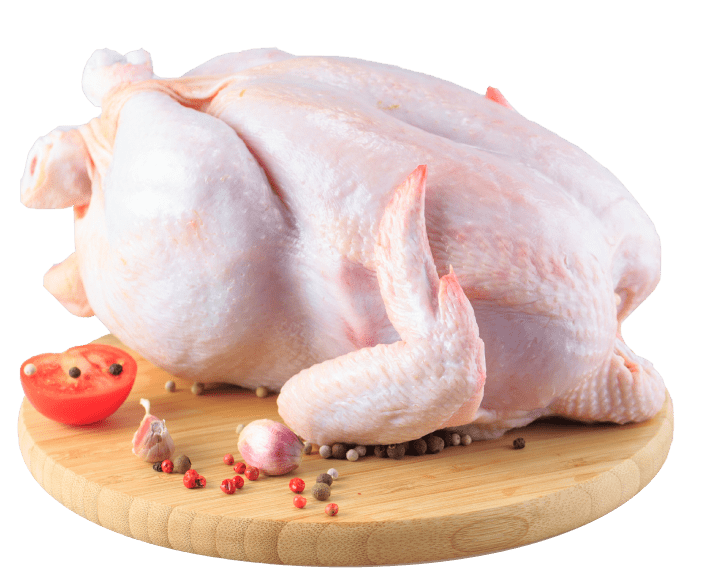
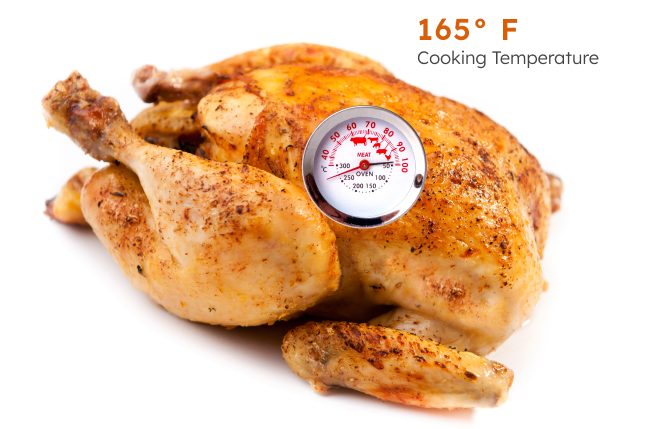
Poultry and chicken are the most notorious for carrying harmful bacteria like salmonella. So, at what temperature is chicken done? It is essential to cook to a safe minimum internal chicken temperature of 165 F to minimize the risk of contracting foodborne illness. You can check the temperature of your poultry by grabbing a food thermometer and placing it into the innermost part of the thigh, wing, and thickest part of the breast.
In theory, uncontaminated chicken can be eaten raw. In fact, some places in the world, like Japan, prepare raw chicken dishes much like raw fish. So, what’s the difference between the chicken served at these places and the chicken you would prepare at home?

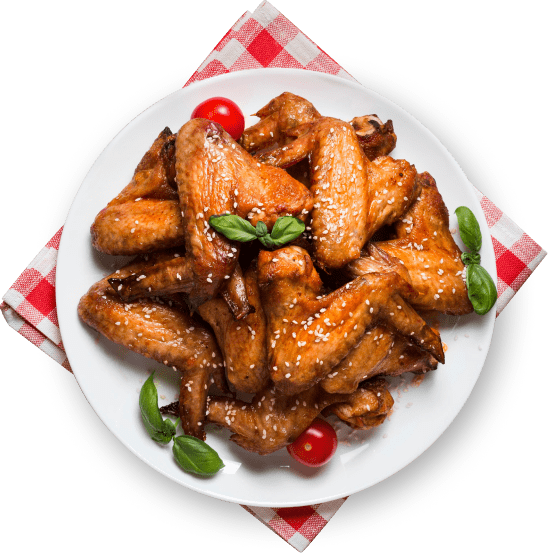
All poultry needs cooking thoroughly, but some dishes may require a higher temperature than the minimum of 165 F to unleash their full flavorsome potential.
The wing is just one instance. For example, the internal temperature of a chicken wing can range anywhere from 165 F to 185 F. Chicken wings become wonderfully tender, succulent, and juicy when cooked to a higher temperature, falling deliciously off the bone. Check out our chicken temperature chart if you need help finding the right temperature for your poultry.
Restaurants that serve raw chicken get their produce from small, controlled farms that make it safer to serve raw.
However, this is certainly not the case with the chicken you find in your local grocery store. To avoid the health risks of uncooked chicken, you must cook it all the way through to at least 165 F!
Checking the temperature of stuffed chicken or turkey
Checking the temperature of stuffed chicken or turkey is a little different. To plate up the best turkey for your next thanksgiving dinner, there are a few places you will need to insert your cooking thermometer.
Remember to avoid bone, gristle, and fat when inserting the thermometer into the meat.
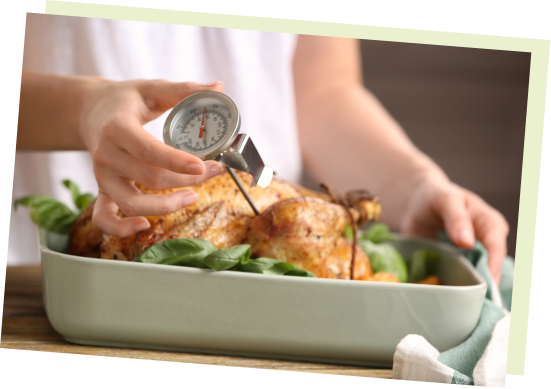
Guide for the best temperature for popular cuts of poultry!
Generally, you should cook poultry to a safe minimum of 165 F. But there are some temperature differences depending on the poultry cut and the recipe you are cooking. Here is a brief guide looking at the best temperature for popular cuts of poultry!
Breast 165°
Thigh 170° F, around 25-30 mins on the grill
Roast chicken check thigh (170 F) and breast (165 F)
Drumsticks 175° F
Wings 175° F
Ground Poultry 170° F – 170° F
Fish/ Seafood

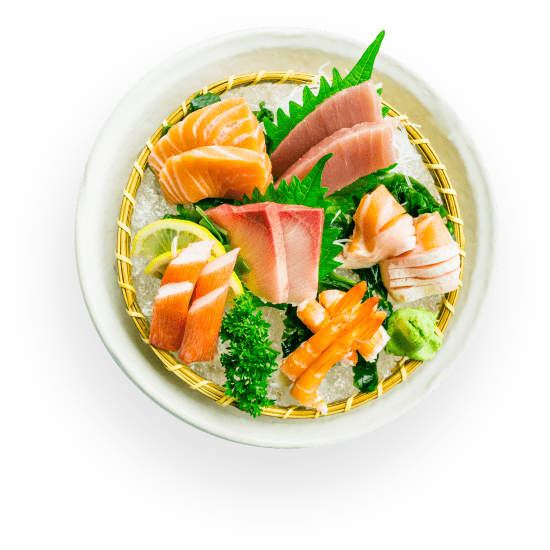
Fish are a special case when considering levels of doneness, as a lot of seafood can be eaten raw.
Sashimi and sushi are popularly eaten worldwide and famously contain raw fish. Seafood like salmon, seabass, tuna, mackerel, eel, and squid are among a few that are eaten raw widely throughout many cultures. Of course, there are still risks to eating raw fish, but the bacteria found on fish are less toxic to humans than the ones found on raw land animals.
Rather than killing bacteria in high temperatures, raw fish is often plunged into freezing temperatures to remove any nasty bacteria.
However, raw fish and seafood should not be eaten without care or thought. Restaurants that serve raw fish select their produce carefully, with professionals who know what to look for and avoid. According to the USDA, the safe cooking temperature for fish is 145 F. However, some chefs prefer to cook it less, depending on the type of fish. If you decide to prepare raw fish at home, try sourcing your meat from a fishmonger and ask them directly for quality fish that you plan to eat raw. If the fish is “sashimi grade,” it is safe to prepare raw for a beautifully fresh ocean bite.
Seafood you shouldn’t consumed raw
On the other hand, most shellfish should not be consumed raw as you risk becoming ill. We’ve all had that one prawn or muscle from a questionable restaurant that wasn’t cooked properly and have later felt the consequences. The thought of making someone ill might prevent people from preparing fish at a dinner party, but this shouldn’t be the case! Nothing is better than tasting the fresh, salty, and unique textures of seafood.

Before you start cooking, check our doneness guide to find the ideal fish cooking temperature!
Salmon
Salmon is one of the most commonly consumed fish, characterized by its bright orange color when skinned and fileted. It is rich, oily, and packed with omega-3 fatty acids that are good for the heart. Salmon is low in saturated fats and is a good source of protein, which is important for maintaining perfect health.
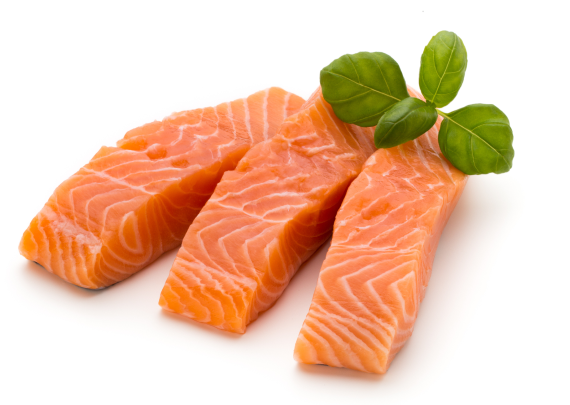
Salmon is truly versatile when it comes to cooking!
Salmon is truly versatile when it comes to cooking! You can pan-sear, roast, boil, grill, and even poach salmon. With the adaptable nature of this fish, there is a salmon recipe out there for everyone! Salmon is also one of the many fish that can be consumed raw. Enjoy delectable bites of salmon sashimi or sushi for the perfect taste of the ocean.
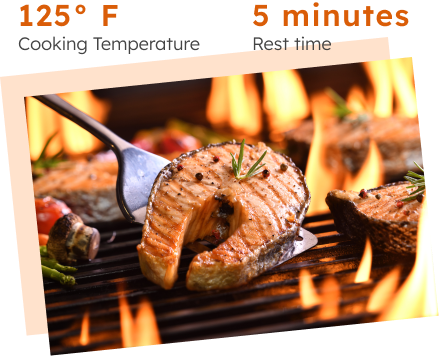
Cooking a salmon
The USDA recommends cooking salmon to 145 F, but the temperature inside the fish continues to rise after taking it off the heat, resulting in dry, overcooked fish. Some chefs recommend cooking salmon at 125 F with a 5-minute rest time after removing it from the heat for the perfect salmon doneness. This should result in a wonderfully succulent dish that is safe to eat!
Halibut
Halibut is a popular lean white fish with firm, meaty flesh and a slightly sweet taste. Halibut contains nutrients that are good for the heart and is a quality source of protein. Because of its gentle taste, halibut pairs easily with more prominent, bolder flavors like lemon, basil, and pesto. It is one of the most favored fish to eat worldwide and is best prepared pan-fried in butter.
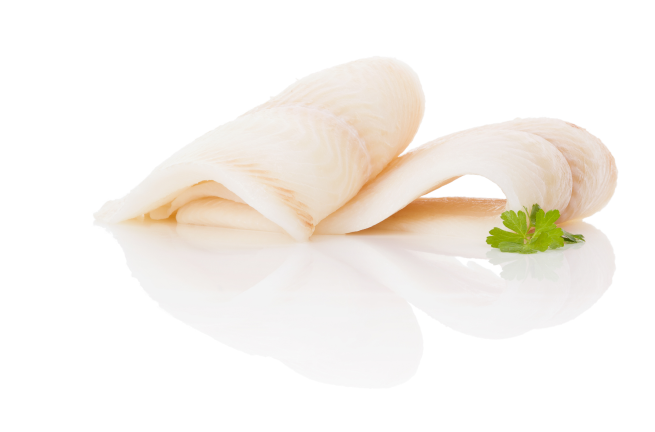
Sashimi-grade halibut is very much a luxury.
When eaten raw, the mild flavors of the fish are thrust into the spotlight and allow you to taste the authentic charm of this fish. We recommend that halibut is flash frozen for up to 6 days before thawing and eaten raw to kill off any parasites on the fish.

Since halibut is a lean fish, it can easily be overcooked and dried. For a firm, flakey fish that is moist and delicious to eat, you should aim to cook halibut at a medium level of doneness. This will have an internal temperature of 130-135 F. The center should look opaque and be removed from heat and rested 5 degrees early when grilling on high heat.
Lobster
Lobster is tender, succulent, juicy, and melts in the mouth! Like most fish, lobster is a healthy source of protein and nutrients like fatty acids. Lobster can be considered a luxury food and often have a hefty price tag in many restaurants. However, the price is well worth it for many seafood lovers, as there is nothing quite like it!

Lobster can be prepared and served in varying ways.
Typically, you can pull delicious meat from the shellfish’s tail, claws, legs, and ribs. When cooking lobster at home, you should give it a quick sniff before starting. If it smells bad and has you scrunching your nose, you should throw it away as it likely went bad. The texture should also be firm rather than soft. If your lobster has a squishy texture, it is safer to throw it out.
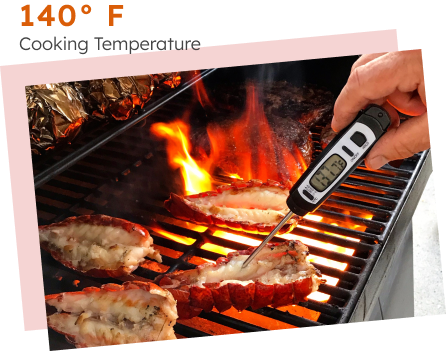
You should ideally cook lobster at an internal temperature of 140 F, and it should never be consumed raw. To check the doneness of your lobster, it is easiest to use an instant red thermometer. Insert the thermometer in the underside of the lobster tail closest to the body and factor rest time into your cooking so as not to overcook your fish.
Shrimp
Shrimp is no doubt a favorite to cook with in many households! Shrimp can be found almost anywhere in the world, making them widely accessible and available to cook in countless ways. While shrimp has a somewhat milder taste than the likes of crab or lobster, it still holds a tasty flavor when boiled, grilled, or served fresh on a salad!
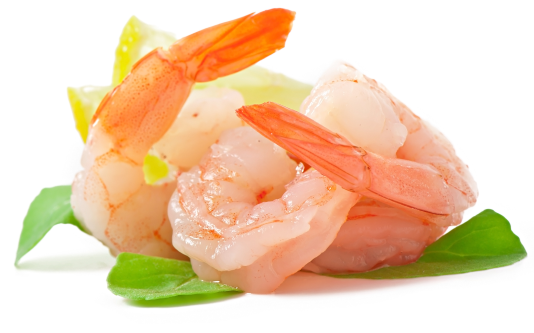
Shrimp cocktail is a simple and delicious dish to prepare for any party and is best served cold.
However, shrimp is often used in many dishes that you can give an Asian, Italian, Spanish, and Mexican-inspired flair. When cooking raw shrimp, the color turns from a dull grey to a beautiful, vibrant pink. Many rely on this color change to indicate when the shrimp is done cooking.
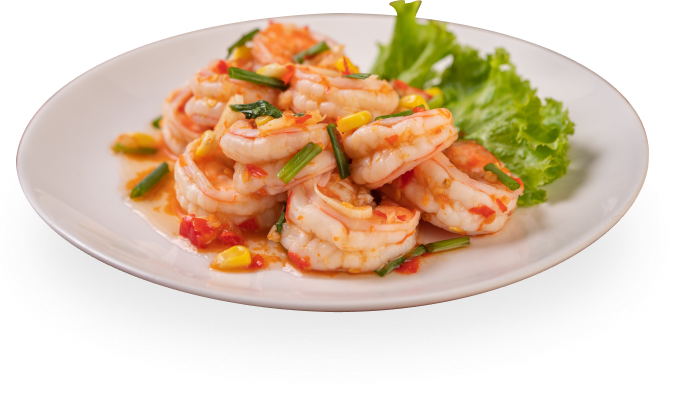
However, shrimp is often used in many dishes that you can give an Asian, Italian, Spanish, and Mexican-inspired flair. When cooking raw shrimp, the color turns from a dull grey to a beautiful, vibrant pink. Many rely on this color change to indicate when the shrimp is done cooking.
Cod
Cod is a popular flakey white fish that is easy to prepare in several ways and comes with various health benefits. This fish is high in protein but low in fat, making it an excellent option for those on a stricter diet. Cod has a mild fishy taste and flakey texture, pairing beautifully with almost any seasonings you put on it. Cod is famously served battered and fried to make the popular British staple, fish and chips!

Cod is highly accessible and affordable!
You can find cod easily at your local grocery store or seafood counter. Most places offer fresh or frozen cod that are often filleted for your convenience. Cod is safe to store in the fridge for a couple of days, but fresh cod is best prepared and served on the same day of purchase.
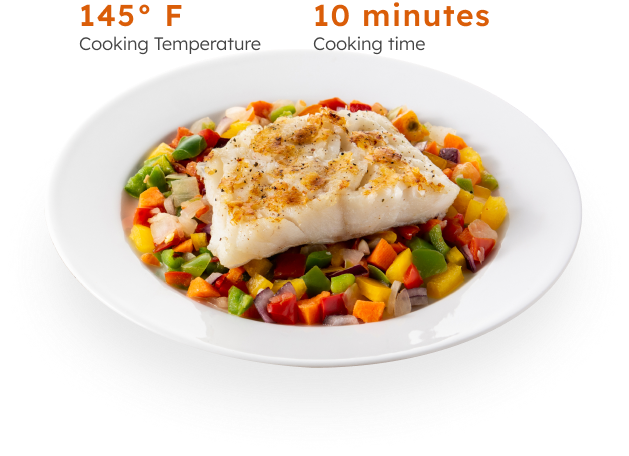
Cod is commonly prepared on the grill and should be baked for around 10 minutes to an internal temperature of 145 F. This is the recommended temperature for cooking fish and is a safe option if you are ever unsure. Your fish is done when it flakes after pressing down with a fork. When you have finished cooking, the cod should be opaque white and will melt in the mouth, served deliciously with a sprinkle of pepper and lemon.
Conclusion
Without the correct information, cooking can often feel like a daunting task.
Each meat is prepared in different ways and has unique doneness levels. Undercooking meat can lead to serious health problems, while overcooking meat can ruin your dish. With so much at stake, it’s important to know the ideal times and temperatures of the food you are cooking. Luckily, you can use our handy article as your cooking guide whenever you question your meat’s doneness.
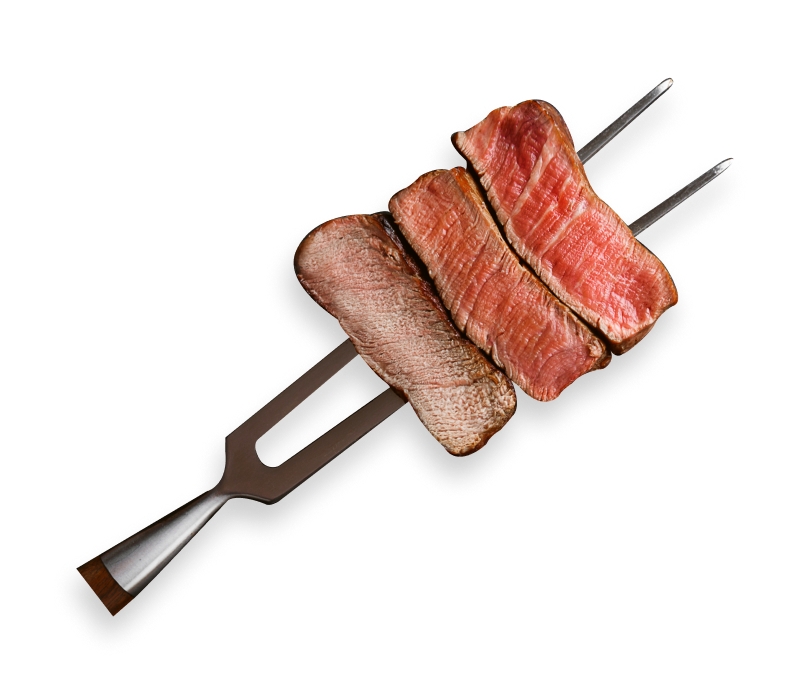
Cook to the tastes of your guests by checking our guide for the perfect medium-rare steak, and never second-doubt the doneness of your chicken again by examining its internal temperature.
While the appearance of your food can certainly tell you when it’s close to being ready, checking the internal temperature ensures you don’t overcook or undercook it.
Don’t take risks when it comes to your food!
Cross-contamination and inadequate cooking is the primary cause of food poisoning, as harmful bacteria live on raw meat. However, you can easily avoid this with our helpful meat cooking temperature guide for a stress-free experience that has your dishes cooked to perfection every time!
What is the difference between rare, medium, and well-done meat?
The difference between rare, medium, and well-done meat is based on the internal temperature of each cut.
- Rare: An internal temperature between 120°F – 130°F
- Medium Rare: An internal temperature between 130°F – 140°F.
- Medium: An internal temperature between 140°F – 160°F.
- Well Done: An internal temperature over 160°F.
The lower the cooking temperature, the less time the steak needs to cook to be done; a rare steak will take much less time than one that’s well done. It’s important to note that it’s not recommended to cook steaks past medium as they will become dry and tough once they hit temperatures over 160°F.
What is the ideal cooking time and temperature for each type of meat?
The ideal cooking time and temperature for each type of meat can vary depending on the specific cut, size, and personal preference. However, here are some general guidelines:
Beef:
- Steak: Cook on high heat (400-450°F or 204-232°C) for 3-6 minutes per side for medium-rare, or 6-10 minutes per side for medium to well-done.
- Roasts: Cook at a low heat (250-350°F or 121-177°C) for several hours until the internal temperature reaches the desired level of doneness.
Pork:
- Chops and tenderloins: Cook on medium-high heat (375-400°F or 191-204°C) for 4-6 minutes per side, or until the internal temperature reaches 145°F (63°C).
- Roasts: Cook at a low heat (250-350°F or 121-177°C) for several hours until the internal temperature reaches 145°F (63°C).
Chicken:
Breasts: Cook on medium-high heat (375-400°F or 191-204°C) for 6-8 minutes per side, or until the internal temperature reaches 165°F (74°C).
Thighs and drumsticks: Cook on medium-high heat (375-400°F or 191-204°C) for 8-10 minutes per side, or until the internal temperature reaches 165°F (74°C).
How do I cook a rare steak?
To cook a rare steak, you’ll need to preheat your oven or pan to 400°F. Place the steak in the pan and cook for 4 minutes on each side. Using an instant-read thermometer, check the internal temperature of the steak to see if it has reached 120°F – 130°F; if not, cook for another minute or two before checking again. Once it has reached the right temperature, remove it from the heat and let it rest before serving.
How do I cook a medium steak?
To cook a medium steak, preheat your oven or pan to 350°F. Place the steak in the pan and cook for 7 minutes on each side. Using an instant-read thermometer, check the internal temperature of the steak to see if it has reached 135°F – 145°F; if not, cook for another minute or two before checking again. Once it has reached the right temperature, remove it from the heat and let it rest before serving.
How do I cook a well-done steak?
To cook a well-done steak, preheat your oven or pan to 325°F. Place the steak in the pan and cook for 12 minutes on each side. Using an instant-read thermometer, check the internal temperature of the steak to see if it has reached 155°F; if not, cook for another minute or two before checking again. Once it has reached the right temperature, remove it from the heat and let it rest before serving.
How do I cook a rare roast?
To cook a rare roast, preheat your oven to 350°F. Place the roast in the pan and cook for 8 minutes per pound, or until it reaches an internal temperature of 130°F using an instant-read thermometer. Once it has reached the right temperature, remove it from the heat and let it rest before serving.
How do I cook a medium roast?
To cook a medium roast, preheat your oven to 375°F. Place the roast in the pan and cook for 10 minutes per pound, or until it reaches an internal temperature of 145°F using an instant-read thermometer. Once it has reached the right temperature, remove it from the heat and let it rest before serving.
How do I cook a well-done roast?
To cook a well-done roast, preheat your oven to 400°F. Place the roast in the pan and cook for 12 minutes per pound, or until it reaches an internal temperature of 160°F using an instant-read thermometer. Once it has reached the right temperature, remove it from the heat and let it rest before serving.
What is the difference between rare, medium, and well-done chicken?
The main difference between rare, medium, and well-done chicken is the internal temperature that it’s cooked to. For rare chicken, the internal temperature should be at least 145°F; for medium chicken, the internal temperature should be at least 170°F; and for well-done chicken, the internal temperature should be at least 180°F.
What is the difference between rare, medium, and well-done fish?
The difference between rare, medium, and well-done fish is the internal temperature that it’s cooked to. For rare fish, the internal temperature should be at least 125°F; for medium fish, the internal temperature should be at least 145°F; and for well-done fish, the internal temperature should be at least 165°F.